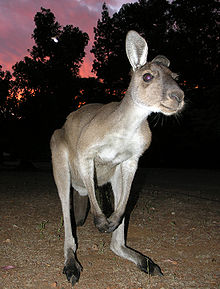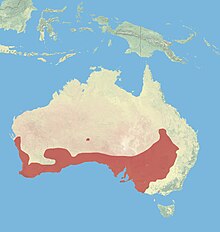Western grey kangaroo
| Western grey kangaroo | |
|---|---|
 |
|
| Wild western grey at sunset, Western Australia | |
| Scientific classification | |
| Kingdom: | Animalia |
| Phylum: | Chordata |
| Class: | Mammalia |
| Infraclass: | Marsupialia |
| Order: | Diprotodontia |
| Family: | Macropodidae |
| Genus: | Macropus |
| Species: | M. fuliginosus |
| Binomial name | |
|
Macropus fuliginosus Desmarest, 1817 |
|
 |
|
| Western grey kangaroo range | |
The western grey kangaroo (Macropus fuliginosus), also referred to as a black-faced kangaroo, mallee kangaroo, and sooty kangaroo, is a large and very common kangaroo found across almost the entire southern part of Australia, from just south of Shark Bay to coastal South Australia, Western Australia, western Victoria, and the entire Murray–Darling basin in New South Wales and Queensland.
Long known to the Aboriginal Australians, for Europeans, the western grey kangaroo was the centre of a great deal of sometimes comical taxonomic confusion for almost 200 years. It was first noted by European explorers when Matthew Flinders landed on Kangaroo Island in 1802. Flinders shot several for food but assumed that they were eastern grey kangaroos. In 1803, French explorers captured several Kangaroo Island western grey kangaroos and shipped them to Paris, where they lived in the Ménagerie du Jardin des Plantes for some years. Eventually, researchers at the Paris Museum of Natural History recognised that these animals were indeed distinct from the eastern grey kangaroo and formally described the species as Macropus fuliginosus in 1817. For reasons that remain unclear, the species was incorrectly described as native to Tasmania.
There the matter rested for over 100 years, and it was not until 1917 that researchers realised that the "forester kangaroo" of Tasmania was in fact Macropus giganteus, the same eastern grey kangaroo that was, and still is, widespread in the southeastern part of the mainland. By 1971, it was understood that the Kangaroo Island kangaroo belonged to the same species as the kangaroos of southern and Western Australia, and that this population extended through much of the eastern part of the continent as well (see range map). For a time, three subspecies were described, two on the mainland and one on Kangaroo Island. The current classification scheme emerged in the 1990s.
...
Wikipedia

